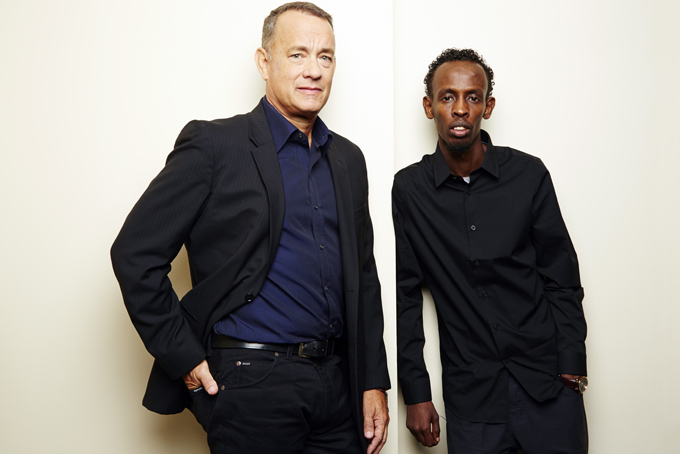
This Sept. 27, 2013 photo shows actors Tom Hanks, left, and Barkhad Abdi, of “Captain Phillips,” in New York. (Photo by Dan Hallman/Invision/AP)
by Tricia Escobedo
(CNN) — Ruthless pirates try to hijack an unarmed American ship. They seize the captain and, after negotiations fail, Navy SEALs stage a daring rescue. It reads like the plot of a Hollywood movie.
And now it is one. The real-life events that surrounded the 2009 attempted seizure of the Maersk Alabama inspired the film “Captain Phillips,” which will be released on Friday.
When asked about taking on the leading role in the film, Oscar-winning actor Tom Hanks said his main focus was accurately portraying Capt. Richard Phillips’ story.
“I don’t want to ruin his life by, you know, turning his motivations into something they weren’t,” Hanks said earlier this month. That can be difficult, Hanks said, because of “the fakery that goes on” in creating a cohesive screenplay based on real-life events.
“When we met, I told Rich, I said, ‘Hey, look, I’m going to say things you never said and I’m going to be places you never were, but what I’m going for is … authenticity.’ “
Phillips’ crew members say he is not the hero the film will likely present him as. (“If you want to shoot someone, shoot me!” Tom Hanks bravely yells at one of the armed Somali pirates, in the movie’s trailer.)
In reality, Phillips ignored numerous warnings to stay farther off the coast of Somalia, the site of dozens of hijackings, which hit their peak in 2008 and gained international attention. Many of the Alabama’s crew members are suing the shipping company, the Danish shipping line Maersk, in part because they say Phillips deliberately sailed the ship into harm’s way to shorten the trip to Mombasa, Kenya, and save money.
On April 8, 2009, four armed Somali pirates boarded the Maersk Alabama about 380 miles off the Somali coast. After failing to take control of the ship, the pirates seized Phillips and held the captain on a small lifeboat for five days until Navy SEALs shot and killed three of the kidnappers and captured the fourth.
Before the incident, a private maritime security agency called Securewest International had sent e-mail warnings about piracy in the region to all ships in the area; one was sent specifically to Phillips.
Each e-mail was based on information from British and U.S. naval authorities and one urged the Alabama to stay clear of the shipping lanes where Phillips was heading.
“Vessels should consider maintaining a distance of more than 600 nautical miles from the Somali coastline,” one of the Securewest messages advised.
Phillips said to CNN’s Drew Griffin in 2010 and in a court deposition last year that he ignored the numerous warnings that urged him to go farther out to sea.
Phillips is a witness in the lawsuit between some of the crew and the shipping company, scheduled to go to trial in December. When asked last year why he decided not to take the boat farther offshore, Phillips testified, “I don’t believe 600 miles would make you safe. I didn’t believe 1,200 miles would make you safe. As I told the crew, it would be a matter of when, not if … We were always in this area.”
After his rescue by U.S. Navy SEAL commandos, Phillips was lauded as a hero and wrote a book about his ordeal, “A Captain’s Duty.” The publisher promoted him as a sea captain who risked his life by offering himself as a hostage “in exchange for the safety of the crew,” something Phillips later acknowledged was a falsity spread by erroneous media reports.
“I didn’t give myself up,” he told Griffin during his book tour in 2010. “I was already a hostage by then.” He later said, “The media made everything out to be me. But that’s the media. When I came home, I really didn’t go and put myself in front of the media. A lot of my crew did. I didn’t.”
He said the real heroes are the Navy SEALs and his crew, who he said stayed calm, followed orders and instincts, and prevented a tragedy.
“They did a wonderful job,” he said. “It’s in the book. Everywhere I speak, I say what a great job they did.”
CNN’s Drew Griffin and David Fitzpatrick contributed to this report.